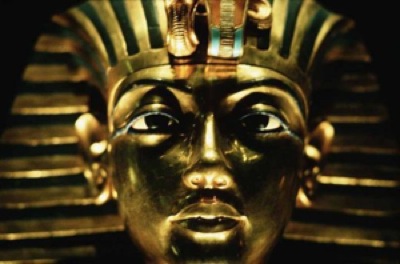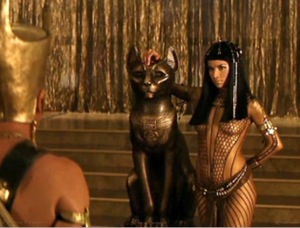Click here to print
Your Loss of Archival Material, in Perspective
posted July 6, 2010

You might like to read the article just to put into perspective your own inability to locate…oh, perhaps one reel from that set of 73 that you received from that estate sale in 2003.
The report draws on a more scientifically oriented and equally impressively headlined account in the June 11, 2010 issue of New Scientist, “On the trail of Tutankhamen’s penis,” by contributing writer Jo Marchant.
She reported that a letter published in the Journal of the American Medical Association that week had suggested that the boy pharaoh died not from an inherited bone disorder and malaria, but from sickle-cell anemia, a genetic condition in red blood cells that sparks organ failure.
If you follow down the trail of links in those articles, you’ll come to Egypt’s chief archaeologist Zahi Hawass, German scientists Christian Timmann and Christian Meyer of the Bernhard Nocht Institute for Tropical Medicine in Hamburg, and a pair of US researchers who believe that King Tut and his relatives might have suffered from a hormonal disorder that causes elongated skulls and foreshortened male genitals.
The Americans – Irwin Braverman of Yale Medical School and Philip Mackowiak of the Veterans Affairs Medical Center in Baltimore, Maryland – believe that the abnormality, Antley-Bixler syndrome, another genetic disorder, might explain why Tut and his old man, Akhenaton, were portrayed at the time with feminine bodies, with hips and breasts, and long heads.
Hawass, the Egyptian head archeologist, responded that that seemed unlikely, because Tut had a “well-developed” loin. But he did not release photographic evidence of the mummies that would prove his claim – his team has exclusive access to the mummies.
So, our intrepid reporter, Jo Marchant, did the proper journalistic thing and looked for other substantiation of Hawass’s claim. That’s when she discovered a note in a paper by him admitting that Tut’s penis was not, in fact, attached to his body – at least, to his mummy (attachment theory would no doubt have something to say about his mommy having also been his aunt – see, below).
“I smelled a conspiracy,” wrote Marchant. “Could ancient Egyptian embalmers have replaced the royal member to hide the fact that their king’s manhood was somewhat lacking? What’s more, the front of Tut’s chest is missing, so it’s impossible to check whether he did indeed have breasts. Was this part of the mummy’s anatomy sabotaged too?”
She learned from John Taylor, caretaker of mummies at the British Museum in London, that when the mummy was unwrapped in 1922, the penis was indeed appended. So, concluded Marchant, “the breakage must therefore have occurred in modern times, perhaps during a particularly brutal autopsy.” She learned that the wayward organ was reported missing in 1968, but it was found again in 2006, in loose sand at the mummy’s side, during a CT scan.
Despite Hawiss’s insistence that the pharaoh was no inkling in the winkling, Marchant wonders whether someone has tried to ensure that no one discover to the contrary. She believes that the evidence at least suggests that someone swapped out Tut’s penis after his mummy was embalmed.
Scientists will, of course, reach their conclusions, and squabble about them. Historians will take interest, too, as they long have in Tut. He reined from 1333 to 1324 BC, at the end of his short life – he rose to the throne at the tender age of approximately 10 during the Egyptian “New Kingdom.” In 1922, Howard Carter discovered Tut’s intact tomb, prompting broad interest in the pharoah’s life and reign and in ancient Egypt, in general. Artifacts from the tomb have toured far and wide, ever since, and scientists have long tried to establish the facts of Tut’s life and parentage. In February, 2010, DNA testing showed that he was the son of Akhenaton and his sister, who was also his wife and who is known only as The Younger Lady or Mummy KV55 – a moniker not quite as tender as Mommy Dearest, but apparently it served. (One can’t help but imagine Jack Nicholson slapping her impatiently and dumbly across the face.)
All this scientific conjecture, aside, devotees of mummy movies may of course have their own theories. Since Boris Karloff’s lugubrious portrayal of the pharaoh Imhotep in the 1932 Mummy, Hollywood and other founts of popular film have fed the frenzied fantasies of mummy lovers. Karloff returned to life long after being embalmed, but that was no more unlikely than anything else about the original mummy movie, nor any that followed.
All manner of projects got in on the fad. In 1939, the Three Stooges in We Want Our Mummy were hired as private detectives to figure out how an Egyptologist, Tuttle, disappeared in Cairo while searching for the mummy of King Rutentuten who turns out to have been a dwarf – perhaps afflicted by an even more severe strain of Tutenkhamen’s condition than he.
{Click on an image to expand}
Scientists who go looking for mummies amidst their thaumaturgical burial trappings often go missing, and certainly no end of silliness drives the films’ plots. In mummy movies over the decades, Lon Chaney and many other B-movie stars of their day have featured among the predictable array of horror- and horrible-movie tropes: buryings alive, horrible disfigurements, and the dead turning out to be undead, as they demonstrate by responding to incantations to raise the dead, or by muttering more of them, perhaps to raise their heavily swaddled kin. In response to seeing mummies walk abroad, archeologists and museologists go insane and spend the rest of their lives in strait jackets, or something of that kind. And why not?
In the Karloff depiction, Imhotep had been cursed for messing with a temple maiden. The injection of fleshly temptations and delights into the genre hardly surprises.Somewhere along the way, even as the acting remained lame and the story lines ludicrous, the movie women of ancient times became less and less clad, perhaps making pharoah’s appendage more available for excision.
The recent discoveries may no doubt inspire someone to flesh out that image in yet another mummy tale for the silver screen.
Are you an aficionado of the mummy movie? Perhaps you’d like to add your theory of the Tut mystery, in the comments.
Printed from Moving Image Archive News: https://www.movingimagearchivenews.org
URL to article: https://www.movingimagearchivenews.org/your-loss-of-archival-material-in-perspective/
Click here to print




